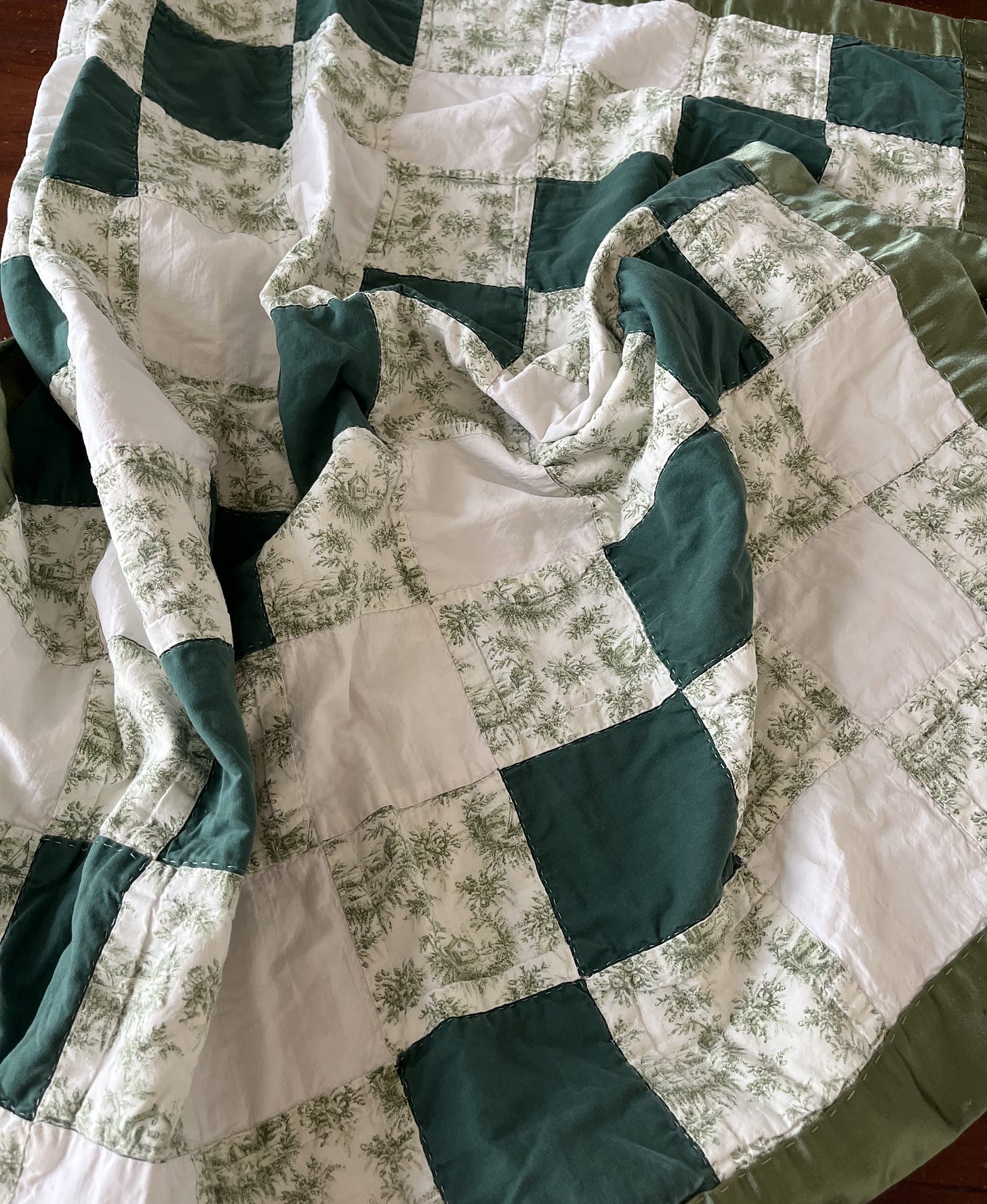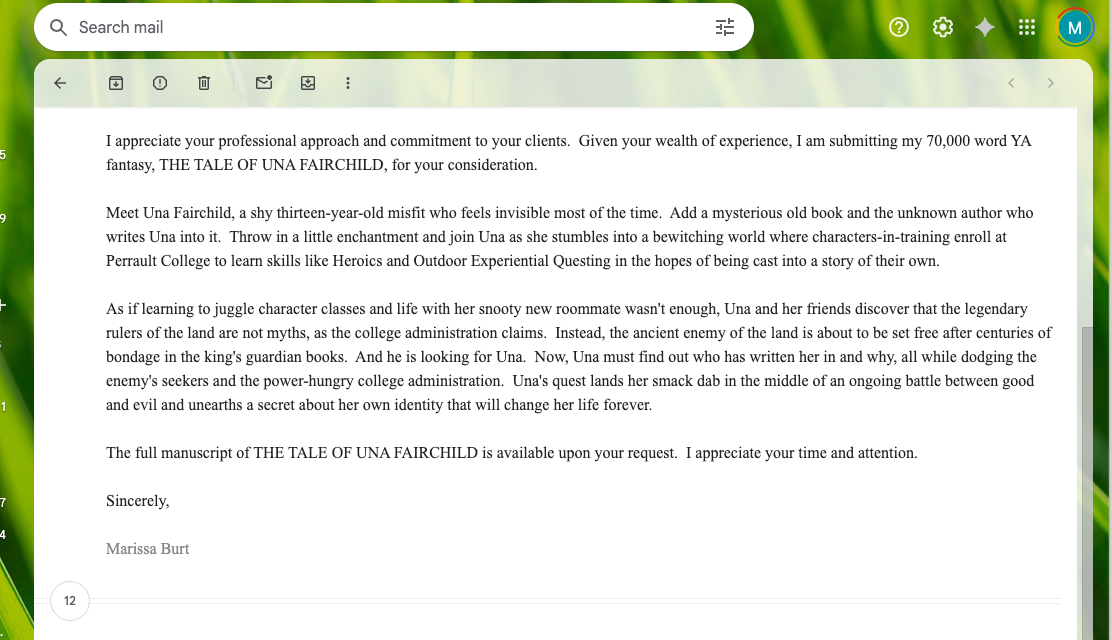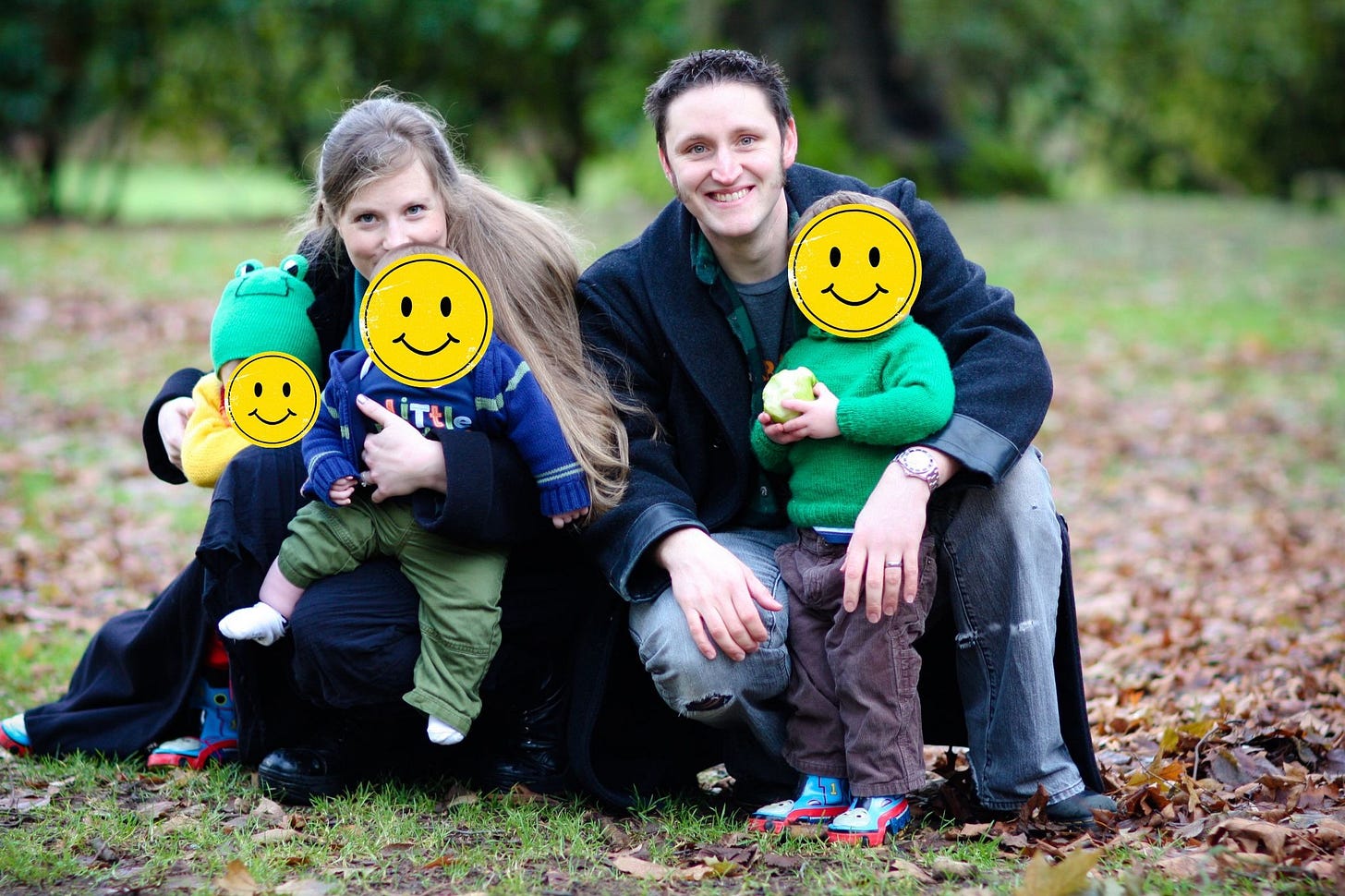Chapter Two: Becoming a Writer
Thoughts on motherhood, writing, and the lifeline of creativity
I wrote Storybound the way I piece together a quilt: an action scene here, a piece of dialogue there—writing as I had time and interest. As the project took shape, I found additional fabric—characters that helped moved the story along, just one more conversation with Samwise the cat, how about stitching together that one scene with this?—and ironed out the puckered and stretched parts, filling in plot holes and messy bits. As I’ve written before, I started out drafting Storybound as a way to navigate the transition to motherhood, and as I discovered things about the Land of Story, I began to discover things about myself as well.

In writing world, you will often here novelists describe themselves as “plotters” or “pants-ers,” meaning: Do you outline your book in detail before drafting or see how it all goes in real time as you write? Pants-ers sometimes refer to their characters as people with minds of their own, agents who grab the reigns from the author and hare off in an entirely different direction. Writing in this way becomes a process of exploration, with many pages created in the drafting stage that may never end up in the final book. Plotters do more up-front planning: a detailed outline, 3-act structure, perhaps even a synopsis. They create a road map for the story, and this “spade-work, as LM Montgomery called it, enables them to guide things along. While I resonate with both, I became a pants-er by accident. The reality of my spaced-out-writing schedule and the intensity of early parenting had me approach writing entirely as a delight-led project. What scene did I want to write that day? What sounded fun?
It was a pleasant process, but my first rough draft needed heaps of editing in the end. I did the best I could, printed off a copy, and stuffed it into a manilla envelope that I passed along to a few early Beta readers. I went to one or two local author gatherings and met some nice people who offered me pats-on-the-back and encouragement rather than the actual critique I really needed. This was 2008, so I took to the internet forums. Absolute Write still has an active community, and back then—pre-reddit, pre-social media, early blogger days—it was a wealth of information. I found an online critique partner willing to read a few chapters, solidarity with other first-time authors, and a forum called “Query Letter Hell.”
The query letter rollercoaster
A query letter is a simple one-page document authors send to literary agents to solicit interest. If an agent likes the project, they’ll set up a call, and if that goes well, an agent may agree to represent an author and get their manuscript on the desks (or in the email inboxes) of acquiring editors. Traditional publishing still operates much the same, and a successful query letter is a mix of professionalism, author personality and luck, story concept, and fortuitous timing. Querying authors agonize over the query, perfecting the recipe, gauging how it lands with others, and then sending it off to their dream agents on the wings of hope.
And then authors come crashing down into the reality of rejection. Anyone setting out to become a published writer should brace themself: rejection from agents, rejection from editors, rejection from reviewers, rejection from readers. . . it’s a rough road, and if you don’t cultivate a little bit of resilience, you might not make it. Not everyone will be a fan of your book . . . or of you. When I first started querying, I went to Barnes and Noble and settled myself into one of those squashy armchairs with a spiral notebook and a cinnamon scone. I poured over the latest edition of the Guide to Literary Agents and jotted down names and emails and mailing addresses in my notebook.
I wasn’t sure if my book was middle-grade or young adult, so I cast the net wide. Some agents had a website or a blog, so I did a little research to try and personalize my queries. In the intervening years, things have changed a great deal. Most literary agents have an online presence, you can connect with them on socials, and there are tools like Querytracker that help you organize your querying process. (If you’d like some tips for querying, check out this post.)
But back then it was simply e-mail. A fair number of agents back then had print query requirements via postal mail, and with both it was: wait for a reply, repeat. I still remember my first rejection. I knew it was likely coming, but I cried a bit as I read and re-read it. My dream agent didn’t want my book? How could that be possible? But querying is and always has been a long shot. I don’t know what the statistics were back then, but nowadays agents sift through thousands of queries each month and only take on a handful of clients each year. Aspiring authors may have a 1-2% chance of getting traditionally published. Of course your chances can vary depending on genre, timeliness of your idea, industry connections, and skillset. But this also means that many ideas and many authors get overlooked. If you’re a querying author reading this: solidarity! It is difficult to put yourself and your work out there, hard to know that someone has skimmed over the thing you’ve spent hours or years on and landed at: sorry, not for me at this time.
Nowadays, agents are so overloaded with queries that you might not even get the form rejection. No reply means no, a sad reality that can make querying feel like a real slog. When I was first querying, most agents still at least replied. I’d get an email or see the familiar handwriting on my self-addressed-stamped-envelope in my mailbox and know it was a politely worded “no,” the latter sometimes coming in months later, long after I landed a literary agent.
Because, for me, the querying process went relatively quickly. I had a few form rejections, and then there was that hope-giving invitation: I’d like to see your full manuscript, please. It was autumn when she reached out, my favorite season and a time when good things happen. I sent off the full manuscript at the beginning of Thanksgiving week, not expecting to hear back right away. Friends came one night for dinner, and in between catching up with them and settling my toddler down for bedtime, I checked my email: “Happy Thanksgiving! I’ve started THE TALE OF UNA FAIRCHILD and wanted to let you know that I like it a lot . . .”
There are no more thrilling words for an author. I like it a lot. At that point, I was expecting my second child. I hadn’t had the heart to do any more writing during pregnancy. I rarely do, and I’ve secretly wondered if this is simply because I only have so much creative energy, and when it’s all funneled into making a person (!!!!), writing falls by the wayside. Instead, I emptied our board game cabinets and laid down on the carpet next to my two-year-old, who was happy to endlessly play with Trivial Pursuit pies and monopoly houses, and together we watched Cars on repeat until the nausea waned. The garden I had planted that spring withered in the South Carolina heat, and as the long haul of the first trimester ended, I was feeling creative once again and a hint of interest and hope about my neglected story. I had wanted to write a novel as a way of finding some solid ground after being at sea from the engulfing transition to motherhood, and here I was, on the other side of the dreaded nausea, with a respected literary agent interested in my book! Happy Thanksgiving indeed!

After the holiday weekend, we scheduled “the call,” a pre-Zoom era phone conversation where we could chat about the book, her work as an agent, and how she thought she might position it with editors. It was as dreamy and as intimidating as you might expect. My agent helped me see that my book was middle-grade, not young adult, that we could try pitching it as a trilogy but I’d need to write up synopses, and she offered some early editorial input. This, of course, happened by snail mail, and she Fed-Exed a printed out copy of my book, perfumed with cigarette smoke and marked up with hand-written proof-reading notations in green ink.
I wanted to tell the delivery driver what exactly was in that fat package when it arrived, but I kept it to myself, snatching nap-time hours to work my way through the manuscript, revising and changing and polishing until it was ready to go out to editors. We had turned a bedroom into a nursery, putting the crib back up in preparation, and I found a new writing nook tucked away in the quiet upstairs. I charted out a schedule and set to work.
I am so grateful for my agent’s early interest in the book and the way she championed it. She set up a pattern of rolling submissions, sending the manuscript out to a handful of editors at a time. The feedback was an emotional rollercoaster. Some editors started out reading with interest, sending along little updates to let my agent know they were interested and not to sell it to someone else before they were done, only to ultimately pass. From this vantage point, I can see why. The idea was compelling. I was on the front end of what would become a stuffed-full genre of fairy tale retellings, genre mashups, and story-themed adventures. But while I had good story-telling instincts, The Tale of Una Fairchild was a piecemeal project. It involved head-hopping. There were plot holes. Inconsistent dialogue. Confusing motivations and backstory. I had a lot to learn.
The interminable waiting of pregnancy and publishing
After six months on submission and nineteen rejections from editors, I began to lose hope. We welcomed our second baby, and I soaked up the postpartum weeks at home. I don’t like to leave the nest in those early weeks. I’d rather stay surrounded by pillows and snacks and DVDs from the library to get me through midnight nursing sessions and a double-stroller to help me break up the daytime hours. The weeks passed, pockmarked by an editorial rejection here and there, and I wondered if my story just wasn’t meant to be.
Plenty of authors will tell you about their “trunked” novels, books that never made it to publication. Many land an agent with a book that never finds a publisher. I began to wonder whether that would be the actual tale for poor little Una & Co., who were frozen in my imagination, stuck in the closing scene of the book, perhaps forever. And then an editor at Harper reached out. Tara Weikum liked the idea; her team liked the world and the characters, but they recognized the story needed work. She asked for an exclusive revision. In other words, it wasn’t an offer, but Tara and her team were willing to work with me to see if I could revise the book into something they wanted to acquire.
It was a risk. I could end up revising my book with no offer at the end. But it also was a reward. I’d have an editor at HarperCollins Children’s giving me input into my book! What an opportunity! I jumped to take it. We withdrew the manuscript from other editors, and I had a phone call with Erica Sussman. In the thick heat of a South Carolina summer, I sat outside on my front porch swing talking about the Land of Story to the background music of my toddler and infant. We chatted through the details, and Erica said she’d send along an initial editorial letter.
I read through it a month later as I nursed my 5-month old baby. We had flown from the south back to the west coast for a dear friend’s wedding, and juggling matron-of-honor duties, traveling with two small children, and the highs and lows of early postpartum made this hard-won milestone very welcome. The list wasn’t very long. The ideas seemed doable. I was eager to get to work. Carving out time to revise was challenging, but I was also very motivated. We were far enough out from the post-partum fog, that my husband and I each had our “night off” again, and so I worked through each stage of edits. This part of the process always feels like a jigsaw puzzle to me, as though all the pieces have been dumped out on the table, and it’s time to piece things together and arrange and see if you can make everything fit within the clear borders.
I was pleased with the end result, and sent it off, hoping the next response might be a book deal. A few months later Erica asked about another revision, this time with a full thirteen page editorial letter. It came as a bit of a surprise, as did the news that I was expecting a third baby. I remember sitting on my stairs looking out the back window in disbelief. I already had a baby. It couldn’t possibly be that another was on the way. I wept as I fast-tracked weaning and wept again when the morning sickness hit. Three children under three, with sixteen months between the younger two, and my husband had just signed up to travel back to the Pacific Northwest every other month to help coach church plants.
I don’t know how we found the energy to keep up, but maybe that’s just my current age talking. He made the trips, and friends and family helped me out, and I somehow miraculously made it through another first trimester surviving on plain potato chips and the extended features section of The Lord of the Rings. For me, my writing story will always be wrapped up with the story of motherhood, not just because my writing nourished me as I poured myself out for others, but because mothers of many children mark the seasons by pregnancies and nursing sessions, and child stages, and transitions and departures.
There is no way to untangle the two for me, this constant and shifting creative work that made me both mother and writer. After a third and smaller revision, Harper ultimately bought my book, pitched as a duology, after which additional rounds of revision awaited me on the other side of that. I wasn’t humble-bragging when I said the story needed a lot of work, which might give a word of warning to other pants-er writers. But I’m grateful for the process. I learned so much along the way—about the craft of writing, story-building, and many layers of construction and shaping that make a story.
There were other exciting writing milestones during this time: foreign rights interest in Storybound (it ended up being published in Italian, a special thing for me given my Italian heritage), film interest (once upon a time someone at Dreamworks read my book!), learning about cover design and audiobook narrators, taking my first round of author headshots, and all the many details that go into bringing a book to print. I was pleased and delighted with every step of the process, and this busy writing season wove together with a cross-country move to the Seattle area. Yes. You read that right. We packed up our three-children-three-and-under, and when the youngest was six weeks old, moved to Washington state.
I went from my cozy office to a booth in the corner of a local Panera, just down the street from our two bedroom apartment. Our discretionary time evaporated as my husband and I tossed childcare responsibilities back and forth—he was helping coach multiple church plants between Seattle and Portland, and I was now writing undeer contract. I didn’t have the luxury of pausing my writing work and instead spent any and all margin time polishing up Storybound and dreaming up the outline for what would eventually become Story’s End (initially titled Storyking).
It makes sense as I write about it now, that this season and timeline is a bit of a blur. We lived in an urban setting, and I put miles on my Bob stroller—two small children tucked one right behind the other and my baby strapped to my chest. I remember early rainy mornings in the indoor mall play area, a big park with a duck pond, the bright spot of a weekly local mom’s group at the nearby Catholic church, and many trips to the grocery store. Our apartment was across the parking lot from one, so when we all felt just too cooped up, I would pack up the children, do another shopping run, and ask the teenage bagger to help me push the cart right up to our steps. My toddler thought donut holes were called “samples” for the longest time, because the bakery department always had them out for children. Between that and him throwing up his hands in the air, because nearly every trip had someone remarking how full my hands were, we learned a new vocabulary as a family in the Seattle area.
My husband was still regularly traveling from Seattle to Portland for his work, and we leaned on extended family and exhausted all our reserves. We were operating well past our capacity but hadn’t quite realized it yet. Our days had become logistical riddles, like the mathematical impossibility of getting myself, three children, and our bags of dirty clothes down to the apartment laundry room—my own version of the farmer getting a fox, chicken and grain across the river. Every once in awhile, I’d steal away to the local Barnes and Noble. Coffee in hand, I’d browse the shelves, not for comparable middle-grade titles, but for sleep solutions for tired mothers.
As I’ve drafted up this post, I’ve checked old emails and contracts to mark the dates. When did I turn in the completed manuscript for Storybound? How did we all fit into that apartment, and what did our neighbors think of the witching hour with three small people and bathtime and midnight feedings? Where did I find time to draft a second novel in the middle of all that transition? Powered by Panera’s chocolate-chip-cookies, decaf coffee with cream, and the way that vinyl booth became a respite from the increasingly overwhelming responsibilities of an intense season of family life, I soaked up my life-line of creativity and story-building.
I also stayed connected in touch with other authors online. Now that I had a pub date, (spring of 2012), I connected with my fellow MG and YA debut authors, some of which were known to me from Absolute Write Query Letter Hell days. We commiserated and celebrate the rollercoaster of debut authorship. A few of us in the area met for some coffee and in-person conversation, finding points of connection from our very different lives over pastries and writing. Some of us would later go on to do some joint group events in the region, and the collegial laughter and solidarity was a grace to me then (and now!)
Launching a book and hitting rock bottom
Many authors will tell you that publication is a s-l-o-w process, and that hasn’t changed. From the day I started writing Storybound to the day it was on shelves, it took nearly four years—about eighteen months of that came after signing a contract. It takes time to bring a book to print, to prepare to market it, to line up all the necessary work that it requires to produce the wonderful volumes we as readers end up holding in our hands. While Storybound was coming to print, I drafted Story’s End, which remains the favorite of all my novels.
With Robert Farrar Capon’s books as my companions, I played with ideas about theodicy, the problem of evil, and what does it mean for God to enter our own Story? It was a delight to draft the book, and I was surprised at where the story took me— evil took shape in zombie-like characters, headlines about the predicted apocalypse formed the Dystopian district, and I found threads of old fairy tales and favorites like The Count of Monte Cristo inspiring scenes.
During that time, we moved out of our two bedroom apartment into the basement level of a duplex, a time that’s blurred with depression and postpartum anxiety and OCD, when the receipt came due for our whirlwind of multiple jobs, back-to-back, pregnancies, writing deadlines, and three-children-under-four. I wrote a bit about hitting rock bottom a few years later, but at the time, I didn’t know why my world was closing into scrupulosity and compulsion, only that it was.
My memories of my book launch are mixed in with the challenges of these days, the fractured kind of being in the world that is known to any who navigate mental illness. It’s a bittersweet memory, really, because I wish I could go back to younger me and help her to know how to soak it all up—all that hectic heyday of Very Young Children, all the emotions of a book in the world, all the messiness of discovering one’s own limits. Perhaps some of the themes on Story’s End reflect the challenges of my own life. As people who love books can tell you, reading can be a form of comfort—a way to escape or untangle difficulties in real life. So, too, can writing be a place to process, to work out on the page things going on underneath the surface.
It wasn’t until a year or two later, doing the hard work in therapy of climbing back up out of “rock bottom” that I saw that in my own writing, the moment of vulnerable exposure when I realized my imagination was working out in fiction themes and realities in my own past and life that I hadn’t yet even known to identify.
I don’t know if other writers out there relate to this, but maybe it should be said: author beware. Many people who write memoir or biography or literary fiction know that in a very real sense “writing is easy . . . you just sit down at a typewriter, open your veins, and bleed.” But don’t be fooled! That’s not just for those genres. Put pen to paper, set your imagination free, and you might just find yourself processing things in real time on the page, a different kind of lifeline for those at sea with adult life.
After Storybound was on bookshelves, and Story’s End was drafted, I turned my attention to my next duology, this one a steampunk, scifi fantasy taking shape alongside my own lived-out story. The many nap-time rounds of Mother Goose tales combined with visions of steampunk, astronomy, and becoming a person, all themes that poured out into A Sliver of Stardust—next time in this series reflecting back on writing and motherhood.
Read the first post in this series here.
***
Thanks for reading! This is an ongoing, once-in-awhile series about writing, my novels, and insights into the publication process. If you’re interested in hearing more from me about writing, paid subscribers get access to: my How to Write and Publish a Novel course, which will coach you step-by-step through the planning, drafting, editing, and preparing to publish a 50K word novel, my How to Write a Nonfiction Book Proposal course, which guides you through the drafting and editing of a complete proposal, and my Tips for Querying a Literary Agent one-sheet.
I’d love to hear from you if you’re another writer—let me know your own thoughts on writing and creativity in the comments. —M
***







I'm (yet) unpublished. Reading this felt like looking at a glimpse of my own life right now. Thank you for your vulnerability.
I read Storybound and Story's End in middle school and really enjoyed them! It's fun and informative to hear about your writing process now!